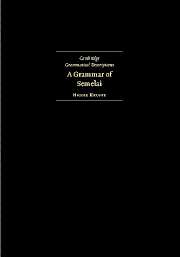Book contents
- Frontmatter
- Dedication
- Contents
- Tables and figures
- Preface
- Acknowledgements
- Abbreviations and conventions
- Maps
- 1 Semelai
- 2 Phonology and phonotactics
- 3 Morphology
- 4 Word classes
- 5 The verb
- 6 Pronouns: personal, ignorative, and demonstrative
- 7 The noun phrase
- 8 Prepositions and the prepositional phrase
- 9 Grammatical relations, constituent order and coding strategies
- 10 Basic clauses
- 11 Complex clauses
- 12 Expressives
- 13 The quotative marker, interjections and discourse clitics
- 14 Texts
- Vocabulary
- References
- Index
Preface
Published online by Cambridge University Press: 05 November 2014
- Frontmatter
- Dedication
- Contents
- Tables and figures
- Preface
- Acknowledgements
- Abbreviations and conventions
- Maps
- 1 Semelai
- 2 Phonology and phonotactics
- 3 Morphology
- 4 Word classes
- 5 The verb
- 6 Pronouns: personal, ignorative, and demonstrative
- 7 The noun phrase
- 8 Prepositions and the prepositional phrase
- 9 Grammatical relations, constituent order and coding strategies
- 10 Basic clauses
- 11 Complex clauses
- 12 Expressives
- 13 The quotative marker, interjections and discourse clitics
- 14 Texts
- Vocabulary
- References
- Index
Summary
This is a description of Semelai, an Aslian language spoken by some 4,000 people in Peninsular Malaysia. The present book is a revision of my doctoral dissertation submitted to the University of Melbourne in 1999. The study is based on a corpus of data collected during an initial period of fieldwork undertaken from July 1990 to June 1991 at Tasek Bera, in the state of Pahang. Insights from recent visits in 2000-1, whilst a postdoctoral student at the Max Planck Institute for Evolutionary Anthropology in Leipzig, Germany, have also been included. Revisions have been completed during a post-doctoral fellowship at the Research Centre for Linguistic Typology, La Trobe University, Melbourne, Australia.
First and foremost, this book represents an initial step in the documentation of a unique and complex language, in an area which to date has been largely neglected by linguists.
My main consideration in writing this grammar was to provide a lucid and accessible account of Semelai for linguists of all theoretical persuasions. The language is described in terms of Basic Linguistic Theory. I have sought to treat equally all aspects of the grammar, examining form and meaning and providing semantic motivations for the various distinctions made within it. A generous number of examples and texts are included to illustrate the discussion and to create a reference work, which will be of use to descriptivists and typologists alike.
- Type
- Chapter
- Information
- A Grammar of Semelai , pp. xvi - xviiPublisher: Cambridge University PressPrint publication year: 2004

